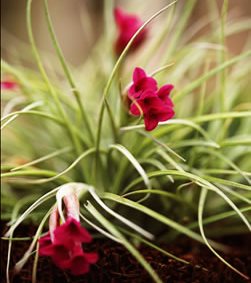Living on Air
Commonly called air plants, tillandsias offer a jewel-like array of foliage and flowers, creating fascinating, symmetrical swirls, spikes and buns of leaves.The largest genus in the bromeliad family, tillandsias can be found from jungle to desert, clinging to tropical trees, cactuses, rocks and even power lines. Native from South America to the Carolinas, with over a dozen species from the United States, including Spanish moss, most tillandsias need no soil, collecting water and nutrients from the air through their leaves. These tough little opportunists have tucked themselves into niches in an amazing range of habitats, and their adaptations make them perfect even for people without green thumbs.
1. T. xerographica
A native of arid regions that grows on cactus and shrubs in Guatemala. Gray leaves twist and curl and form a decorative dome over a foot across. Three-foot bract is green and orange with purple flowers. Sensitive to cold (38 degrees Fahrenheit) and doesn’t like to hold water.
2. T. Capitata
Makes a dramatic color transformation when in bloom, the Granny Smith apple-green leaves turning crimson. Blue tubular flowers peek from foliage in spring. One of the tanking tillandsias (designed to hold water like many bromeliads), it makes a striking container specimen.
3. T. ‘Mystic Albert’
A hybrid that blends the thick, fan-shaped leaves and red flowers of T. albertiana with the soft, symmetrical foliage and pink flowers of T. stricta. Showy, wine-colored clusters of flowers bloom for several weeks during the summer. Small individual plants with soft, gray-green, narrow leaves form fist-sized colonies 4 to 5 inches across.
4. T. leonamiana
Unusual orange inflorescence with small white blooms. Gray-green leaves. A native of South America accustomed to dry conditions. Grows to 6 to 8 inches across. A good candidate to tie to a section of bark or add to a tillandsia wreath.
5. T. vernicosa
Stiff, spiky, gray-green leaves look like a miniature yucca. Architectural bract is scarlet to orange and can hold its color for up to a year, long after the small white flowers have faded.
6. T. funckiana
Small bottlebrushes of silvery, yellow-green leaves form at the ends of stolons. Eventually forms a ball-shaped colony of plants that can be hung like a hanging basket (without the basket). Tubular scarlet flowers are long at 1 1/2 inches. When in bloom, the delicate leaves become red-tipped.
7. T. brachycaulos
A miniature form collected in Mexico by tillandsia expert and former owner of Russell’s Bromeliads John Russell. Lime-green foliage turns bright red during blooming. Forms soft domes of linear foliage, 4 to 6 inches across. Tubular flowers are bright blue and appear late in the season.
Appeal: Tillandsias add a touch of the exotic. Though a few are large, most are small, with a variety of colors and textures that makes it tempting to collect them like shells on the beach. Given their stature this is easy to do, even in a small space.
Zones: In general tillandsias need protection from temperatures below 35 degrees Fahrenheit, though some are hardier than others. For most of the country tillandsias are considered houseplants.
Exposure: The more silvery or white the tillandsia, the more trichomes it has (the cells that collect and store water and nutrients from the air) and the more arid and bright the native habitat, so the more sunlight it can take. Trichomes also have a reflective quality. Greener tillandsias need more shade. Most tillandsias prefer partial shade or bright but indirect light. Protect all tillandsias from direct sun exposure for extended periods.
Soil: Most tillandsias grow as epiphytes attached to trees, shrubs and rocks, using their roots for anchoring. Some, such as T. capitata, can be grown in containers but require great drainage. Plant these in a loose potting medium containing plenty of perlite.
Care: Though in the wild most tillandsias are drought-tolerant and can go periods without water, this is a survival mode. To be at their best, they need regular watering. As houseplants, soak them in bottled water or rain water for 12 hours every 10 days to two weeks. If plants are outdoors, water them when you water your potted plants. Gray or white tillandsias (from arid habitats) prefer less water; greener, softer-leaved types need more. To thrive, tillandsias benefit from regular feeding. Every week or two apply a liquid fertilizer low in copper, such as 10-5-5, diluted to one-quarter strength.
Designing With Tillandias
- As temporary decoration they can have the same impact as cut flowers. Suitable for any sort of container-an elegant glass bowl, a rustic basket-or tucked into a table display, they can endure less-than-ideal conditions for a few weeks, before being returned to the growing situations they prefer.
- Many tillandsias can be attached with fishing line, florist’s wire or hot glue to pieces of wood. But they can also be attached to a grapevine wreath, a metal grid, or a topiary form.
- Once a tillandsia has formed a colony of plants, it can be displayed like a hanging basket.
- Tillandsias also make good neighbors in a terrarium, grouped with plants that need the same environmental conditions, tropical or arid.










